Below Ground Net Primary Production- GLBRC Intensive Sites
Replaced by: Belowground Net Primary Production – Biofuel Cropping System Experiment
In use from 2008-01-01
Abstract
Perennial crops
Surface fine-root production: Root in-growth cores
Fine root production is estimated from root in-growth cores (Bledsoe 1999, Fahey et al. 1999). Two 2-mm mesh cores that measure 5-cm diameter × 13-cm long containing native soil medium are installed at each permanent station within treatment plot at the beginning of the growing season (April/early May). The cores are placed randomly in the interstitial space among vegetation. To determine an approximate peak standing crop, one of the two cores at each sampling station is harvested at mid-season (mid-July) and the other is harvested at the end of the season (October). The roots are washed free of soil over a 2-mm sieve, dried at 60 °C for 48 h, and weighed.
Subsurface standing stock
To allocate fine root production to depths below 13-cm, we will sample standing stock of live and dead root biomass to ~1 m at season’s end (October). Three sets of 3 cores 5-cm diameter × 1-m long will be randomly located and removed from each treatment plot. Cores will be segmented in pre-determined soil horizons. Roots are washed free of soil over a 2-mm sieve, separated into live and dead components, dried at 60 °C for 48 h, and weighed. To account for spatial variability in fine root production, these 1-m deep cores will be removed along plant density gradients moving out from the center of a bunchgrass into the interstitial space. Differences in the distribution of root biomass beneath plants and in the interstitial areas will be modeled as a function of plant functional type cover.
Annual crops
Annual fine and tap root production
In annual crops, plant excavations at the time of plant physiological maturity are used to index belowground primary productivity. All plants in a 1 × 1 m area are excavated, aboveground biomass is discarded and the soil and roots are removed to the laboratory. The roots are washed free of soil over a 2-mm sieve, dried at 60 °C for 48 h, and weighed.
Protocol
Equipment
Perennial crops
Surface fine-root production: Root ingrowth cores
- Soil core hammer w/bit – Model 77557 (Forestry Suppliers – www.forestry-suppliers.com)
- Plastic soil core inserts (1 per core) – 77848 Butyrate Plastic Liner; 2″ × 6″L (Forestry Suppliers)
- Soil core insert caps (2 per core) – 77483 2" Polyethylene Liner Caps (Forestry Suppliers)
- Pre-labeled plastic or paper bags for collection and transport
- 2-mm mesh cores (2 per station)
- Tape measure
- Compass
- Location data sheet
- 2 – mm sieve w/tray
- Aluminum foil or plastic wrap
Procedure
Field
- Locate plot station and determine root ingrowth core locations, orient so that they are not in the ANPP quadrat location (ANPP protocol). Measure 1 and # – m in a pre-determined compass direction away from the plot marker and note locations on the data sheet.
- Place plastic soil core sleeve in the hammer bit and remove soil core from determined location – mark location with a flag.
- Place caps on the plastic soil core insert.
- Place core in pre-labeled bag.
- Remove to lab or processing station.
- After lab preparation (see below) install root ingrowth cores flush with soil surface at appropriate locations.
Lab
- Remove core from insert – hand drill with bit works well (if core is wet it might be necessary to air or oven dry (60 ˚C for 24-48h).
- Wash core free of rocks and roots over a 1 – mm sieve and air dry soil.
- Wrap 2 – mm mesh core with aluminum foil or plastic wrap.
- Fill core with sieved clean native soil.
Making root ingrowth cores
- Cut #5 mesh canvas into 15 × 18 – cm rectangles (Fig. 1) – #5 Plastic mesh canvas (Blue Ribbon Crafts – www.blueribboncrafts.com) and 1 – soil core insert cap (see above for cap info.)
- Staples edges with 2 hole overlap (Fig. 2).
- Apply a small bead of hot glue to soil core insert cap and place into pre-formed mesh core (Fig.3).
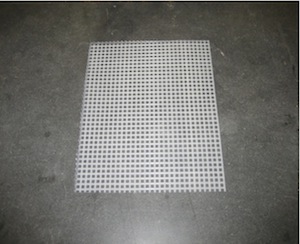
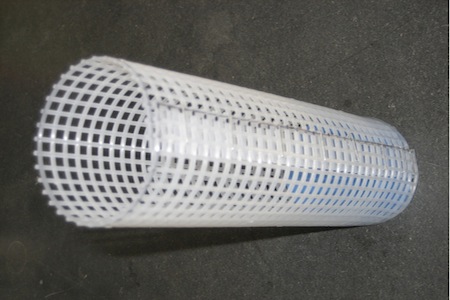
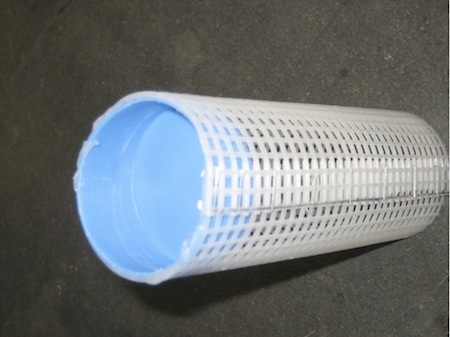
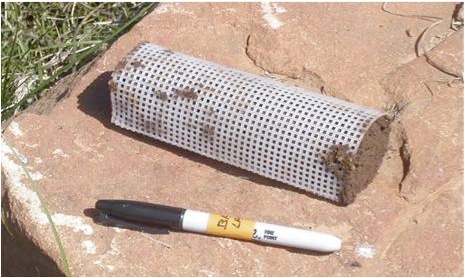
Subsurface standing stock
- Truck with hydraulic soil corer
- 1 – m plastic soil core inserts (1 per location) – Giddings Machinery Co.
- Soil core insert caps (2 per location) – Giddings Machinery Co.
- Marker or label to mark plastic soil core insert
Field
- Remove 1-m deep cores (3) along plant density gradients moving out from the center of a bunchgrass into the interstitial space.
- Remove to lab or processing station.
Lab
- Split plastic soil core insert (Fig. 1).
- Segment into appropriate soil horizons.
- Roots are washed free of soil over a 2-mm sieve.
- Separate into live and dead components.
- Dry at 60 °C for 48 h.
- Weigh and record.
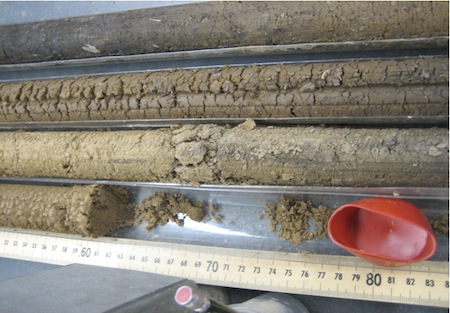
Equipment
Annual crops
Annual fine and tap root production
Quadrat as per ANPP protocol
Shooter shovel
Clippers
Large 50lb. paper sack.
Procedure
Field
- Locate quadrat as per ANPP protocol.
- Excavate all plants in a net 1 × 1 m area (quadrat size per ANPP protocol).
- Aboveground biomass is clipped discarded and the root ball is placed into pre-labeled paper sacks.
- Soil and roots are removed to the laboratory.
Lab
- Roots are washed free of soil over a 2-mm sieve.
- Roots are oven dried at 60 °C for 48 h.
- If desired, tap root can be separated from fine roots.
- Weigh and record.
Date modified: Tuesday, Oct 24 2023
Datatables
- Root Biomass and Total Carbon and Nitrogen of Annual Crops (GLBRC089-001)
- Root Biomass of Perennial Crops by Depth (GLBRC089-003)
- Fine Root Production of Perennial Crops by Ingrowth Cores (GLBRC089-002)
- Root Productivity (BNPP), Total carbon and Nitrogen - Annual Crops (G1-G4) (KBS085-001)
- Belowground Biomass - Perennial Crops (KBS085-003)
- Fine Root Productivity (BNPP) - Perennial Crops (G5-G10) (KBS085-002)
